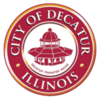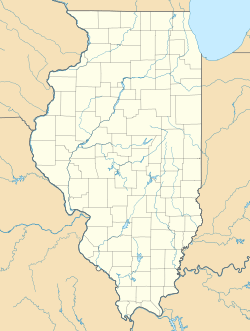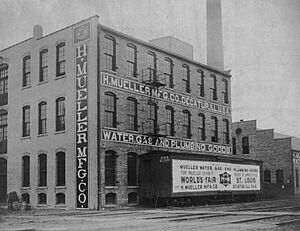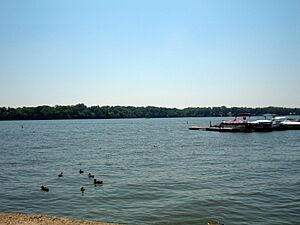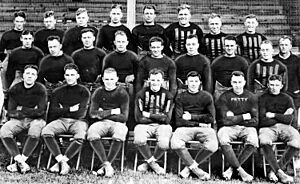Decatur, Illinois facts for kids
Quick facts for kids
Decatur, Illinois
|
||
|---|---|---|
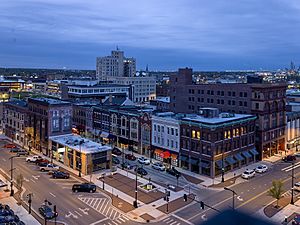
Downtown Decatur
|
||
|
||
| Nicknames:
Soy City, Soybean Capital of the World, Limitless Decatur
|
||
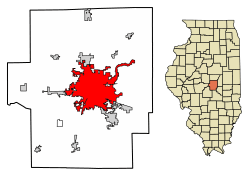
Location of Decatur in Macon County, Illinois
|
||
| Country | ||
| State | ||
| County | Macon | |
| Townships | Decatur, Harristown, Hickory Point, Long Creek, Oakley, South Wheatland, Whitmore | |
| Founded | 1823 | |
| Area | ||
| • Total | 47.79 sq mi (123.78 km2) | |
| • Land | 43.11 sq mi (111.65 km2) | |
| • Water | 4.68 sq mi (12.13 km2) 10.0% | |
| Elevation | 677 ft (206 m) | |
| Population
(2020)
|
||
| • Total | 70,522 | |
| • Estimate
(2022)
|
69,097 | |
| • Density | 1,475.66/sq mi (569.737/km2) | |
| Time zone | UTC−5 (CST) | |
| • Summer (DST) | EDT | |
| ZIP Codes |
62521–62523, 62526
|
|
| Area codes | 217, 447 | |
| FIPS code | 17-18823 | |
Decatur (/dɪˈkeɪtər/ dih-KAY-tər) is a city in Macon County, Illinois, United States. It's the biggest city in the county and also its county seat. The city was started in 1829. It sits along the Sangamon River and Lake Decatur in Central Illinois.
In 2020, about 70,522 people lived in Decatur. This makes it the seventeenth-most populated city in Illinois. Decatur's economy is based on processing farm products and making industrial goods. The city is also home to two colleges: Millikin University and Richland Community College.
Contents
- Decatur's Story: A Look Back
- Decatur's Location and Surroundings
- People of Decatur
- Decatur's Economy: What People Do
- Arts and Culture in Decatur
- Parks and Fun Things to Do
- Sports in Decatur
- Learning in Decatur
- Media: News and Entertainment
- Getting Around Decatur
- Famous People from Decatur
- Sister Cities
- Images for kids
- See also
Decatur's Story: A Look Back
Decatur is named after Stephen Decatur, a brave naval hero from the War of 1812. The city is part of the U.S. Main Street program, which helps protect historic places.
In 1833, the Potawatomi Trail of Death passed through this area. Later, in 1866, the first group of Civil War veterans, called the Grand Army of the Republic, was formed here.
Some famous buildings in Decatur were designed by well-known architects. The Edward P. Irving House, built in 1911, was designed by Frank Lloyd Wright. Other homes nearby were designed by his assistants.
Abraham Lincoln's Connection
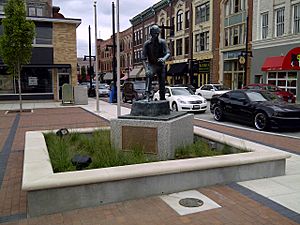
Decatur was the first place Abraham Lincoln lived in Illinois. He moved here with his family in 1830. When he was 21, Lincoln gave his first political speech in Decatur. He talked about how important the Sangamon River was for travel. This speech got the attention of Illinois leaders. John Hanks, Lincoln's cousin, also lived in Decatur.
In 1860, the Illinois Republican Party held a big meeting in Decatur. At this meeting, Lincoln was first supported to become President of the United States. They called him "The Railsplitter Candidate."
Weather Events and Incidents
In April 1996, two tornadoes hit Decatur. One was smaller, and the next day, a stronger one caused more damage. Together, they caused about $10.5 million in property damage.
In 1974, there was a train accident in a railroad yard. A tanker car carrying a gas called isobutane crashed. This caused an explosion that sadly killed seven people and injured many others. It also caused $18 million in property damage.
In 1999, Jesse Jackson and the Rainbow/PUSH Coalition came to Decatur. They protested how some African American students were treated after a fight at a high school football game. Their protest brought national attention to the issue of fairness.
Decatur's Location and Surroundings
Decatur is located at 39°51′6″N 88°56′39″W / 39.85167°N 88.94417°W. It's about three hours southwest of Chicago. It's also 40 miles east of Springfield, which is the state capital. You can drive to St. Louis in about two hours from Decatur.
The city covers about 46.91 square miles (121.5 square kilometers). Most of this area is land, but about 10% is water. Lake Decatur is a large lake here, created in 1923 by building a dam on the Sangamon River.
The Decatur Metropolitan Statistical Area includes Decatur and several smaller towns nearby. These include Argenta, Blue Mound, and Mount Zion.
People of Decatur
| Historical population | |||
|---|---|---|---|
| Census | Pop. | %± | |
| 1860 | 3,839 | — | |
| 1870 | 7,161 | 86.5% | |
| 1880 | 9,547 | 33.3% | |
| 1890 | 16,841 | 76.4% | |
| 1900 | 20,754 | 23.2% | |
| 1910 | 31,140 | 50.0% | |
| 1920 | 43,818 | 40.7% | |
| 1930 | 57,510 | 31.2% | |
| 1940 | 59,305 | 3.1% | |
| 1950 | 66,269 | 11.7% | |
| 1960 | 78,004 | 17.7% | |
| 1970 | 79,285 | 1.6% | |
| 1980 | 94,081 | 18.7% | |
| 1990 | 83,885 | −10.8% | |
| 2000 | 81,860 | −2.4% | |
| 2010 | 76,122 | −7.0% | |
| 2020 | 70,522 | −7.4% | |
| 2021 (est.) | 69,646 | −8.5% | |
| U.S. Decennial Census 2010 2020 |
|||
In 2020, Decatur had a population of 70,522 people. The city's population has changed over time. In 2010, there were 76,122 people living here. About 71.6% of the people were White, and 23.3% were African American. People of Hispanic or Latino background made up about 2.2% of the population.
The average age in Decatur in 2010 was about 39 years old. About 22% of the population was under 18 years old. In 2017, the average income for a family in Decatur was about $55,086.
Decatur has seen its population decrease in recent years. From 2010 to 2019, the city's population dropped by about 7.1%.
Decatur's Economy: What People Do
Decatur is home to big companies that make important products. These include Caterpillar Inc., Archer Daniels Midland (ADM), Mueller Co., and Primient.
Caterpillar Inc. has one of its largest factories in the U.S. here. They make big trucks, scrapers, and other heavy machines for mining. ADM processes corn and soybeans, which are used in many food products. Mueller makes products for water systems, and Primient processes corn.
Decatur is known as an important center for shipping and distribution. It has a special area called the Midwest Inland Port. This port connects different ways of transport, like trains, trucks, and the Decatur Airport. This makes it easy to move goods to many customers.
In 2019, Mueller Company announced plans to build a new factory in Decatur. This factory will make brass products and create about 250 jobs. In 2020, ADM and InnovaFeed announced plans to build a large insect protein facility. This project will create many jobs and help produce sustainable animal feed.
Main Employers in Decatur
Here are some of the biggest employers in Decatur:
| Employer | # of employees |
|---|---|
| Archer Daniels Midland | 4,000 |
| Caterpillar Inc. | 3,150 |
| Decatur Memorial Hospital | 1,903 |
| Decatur Public Schools | 1,752 |
| HSHS St. Mary's Hospital | 930 |
| Ameren Illinois | 630 |
| Millikin University | 600 |
| Primient | 600 |
| Mueller Co. | 585 |
| The Kelly Group | 575 |
Past Businesses
From 1917 to 1922, car companies like Comet Automobile Company were in Decatur. Later, a plant owned by BorgWarner and then Facet Aerospace Products operated here, but it closed in 1983.
Archer Daniels Midland (ADM) used to have its main corporate offices in Decatur. In 2014, ADM moved its top management to Chicago. Also, the Japanese company Bridgestone used to have a large tire factory in Decatur. This factory closed in 2001, and about 1,500 employees lost their jobs.
Arts and Culture in Decatur
Music Scene
The Decatur Municipal Band started in 1857. This makes it one of the oldest non-military bands that has been playing continuously in the United States and Canada. Today, the band is made up of high school and college students, and adults from the area.
Historic Places to See
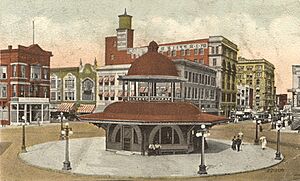
A special symbol of Decatur is the Transfer House. It's an eight-sided building from 1896. It was built in the old town square where streetcars and trains used to meet. It was a shelter for people changing rides. The building was designed by William W. Boyington, who also designed the famous Chicago Water Tower. The top floor of the Transfer House was an open area used for speeches and concerts.
Over time, as more cars came, the Transfer House was moved in 1962 to Central Park. It has been used as a bus shelter, a visitor center, and offices for groups.
The Edward P. Irving House, designed by Frank Lloyd Wright in 1911, is also in Decatur. Other homes nearby were designed by his assistants.
The Public Library
In 1901, Andrew Carnegie gave Decatur money to build a new public library. It opened in 1903. The library moved to different locations over the years. In 1999, it moved to its current home on Franklin Street, which used to be a Sears store.
Parks and Fun Things to Do
Macon County has many parks and natural areas. These include Lake Decatur, Lincoln Trail Homestead State Memorial, and Rock Springs Conservation Area. The Decatur Park District manages over 2,000 acres of park land. They have an indoor sports center, three golf courses, and fields for softball, soccer, and tennis.
There's also a community aquatic center and the Scovill Zoo, which is a certified zoo. Decatur was once called "Park City USA" because it had so many parks for its size. It was also called "Playtown USA" for its focus on recreation.
Sports in Decatur
Decatur was the first home of the Chicago Bears football team! From 1919 to 1920, they were known as the Decatur Staleys. They played at Staley Field, named after a local food company. The team was made up of company employees. When George Halas became coach, the team did very well. To get bigger crowds, the team moved to Chicago in 1921 and became the Chicago Staleys. In 1922, they changed their name to the Chicago Bears.
From 1900 to 1974, Decatur also had a minor-league baseball team called the Decatur Commodores. They played at Fans Field.
Decatur used to host a professional tennis tournament called the USTA/Ursula Beck Pro Tennis Classic. Male players from many countries competed for prize money and world ranking points. The tournament was held every year until 2019.
Learning in Decatur
Colleges and Universities
- Millikin University: This is a four-year college with about 2,400 students. It was started by James Millikin.
- Richland Community College: This college has about 3,500 students. It also hosts the big Farm Progress Show every two years.
- Walther Theological Seminary: This is a seminary for religious studies.
Public Schools
The Decatur Public Schools District 61 provides education for students from kindergarten through 12th grade.
High Schools
- Eisenhower High School
- MacArthur High School
- William Harris Learning Academy
Primary Schools
- American Dreamer STEM Academy
- Baum Elementary School
- Dennis Lab School
- Franklin Grove Elementary School
- Hope Academy
- Johns Hill Magnet School
- Montessori Academy for Peace
- Muffley Elementary School
- Parsons Elementary School
- Pershing Early Learning Center
- South Shores Elementary School
- Stephen Decatur Middle School
- William Harris Learning Academy
Private Schools
High Schools
- Unity Christian School
- St. Teresa High School
- Decatur Christian School (located in Forsyth, Illinois)
Primary Schools
- Antioch Christian Academy
- Holy Family Catholic School
- Unity Christian School
- Our Lady of Lourdes School
- St. Patrick School
Media: News and Entertainment
Newspapers
- Decatur Tribune — a weekly newspaper
- The Decaturian — a student newspaper published by Millikin University
- Herald & Review — a daily newspaper
Magazines
- Decatur Magazine — published every two months
Television Stations
Radio Stations (AM)
- WDZ — 1050 AM — ESPN Radio
- WSOY — 1340 AM — talk radio
- 1650 AM — Community radio
Radio Stations (FM)
- WBGL — 88.1 FM — Christian radio
- WDCR (FM) — 88.9 FM & 96.5 FM — Relevant Radio
- WJMU — 89.5 FM — Millikin University radio, plays alternative rock
- WYDS — 93.1 FM — top 40 music
- WDZQ — 95.1 FM — country music
- WXFM — 99.3 FM — Light Hits
- WZUS — 100.9 FM — talk radio
- WLUJ — 101.9 FM – Moody Christian Radio
- WSOY — 102.9 FM — Top 40 music
- WEJT — 105.1 FM — adult hits
- WCZQ — 105.5 FM — hip hop & R&B
- WZNX — 106.7 FM — classic rock
- WDKR — 107.3 FM — oldies
Getting Around Decatur
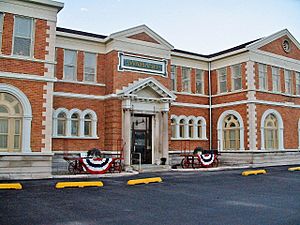
The Decatur Airport has daily flights to and from Chicago-O'Hare International Airport through United Airlines.
Decatur has been a major railroad center for over 100 years. Today, it is served by two large railroads: Canadian National and Norfolk Southern. Smaller local railroads also serve the city.
Major highways like Interstate 72, U.S. Route 51, and U.S. Route 36 connect Decatur to other places.
The Decatur Public Transit System (DPTS) offers bus service around the city. They also have special services for people with disabilities.
Famous People from Decatur
Many interesting people have come from Decatur. You can find a full list of them in the main article.
Sister Cities
Decatur has special connections with cities in other countries. These are called sister cities:
Every year, students from Decatur visit these cities as ambassadors. Students from Japan and Germany also visit Decatur.
Images for kids
See also
 In Spanish: Decatur (Illinois) para niños
In Spanish: Decatur (Illinois) para niños


